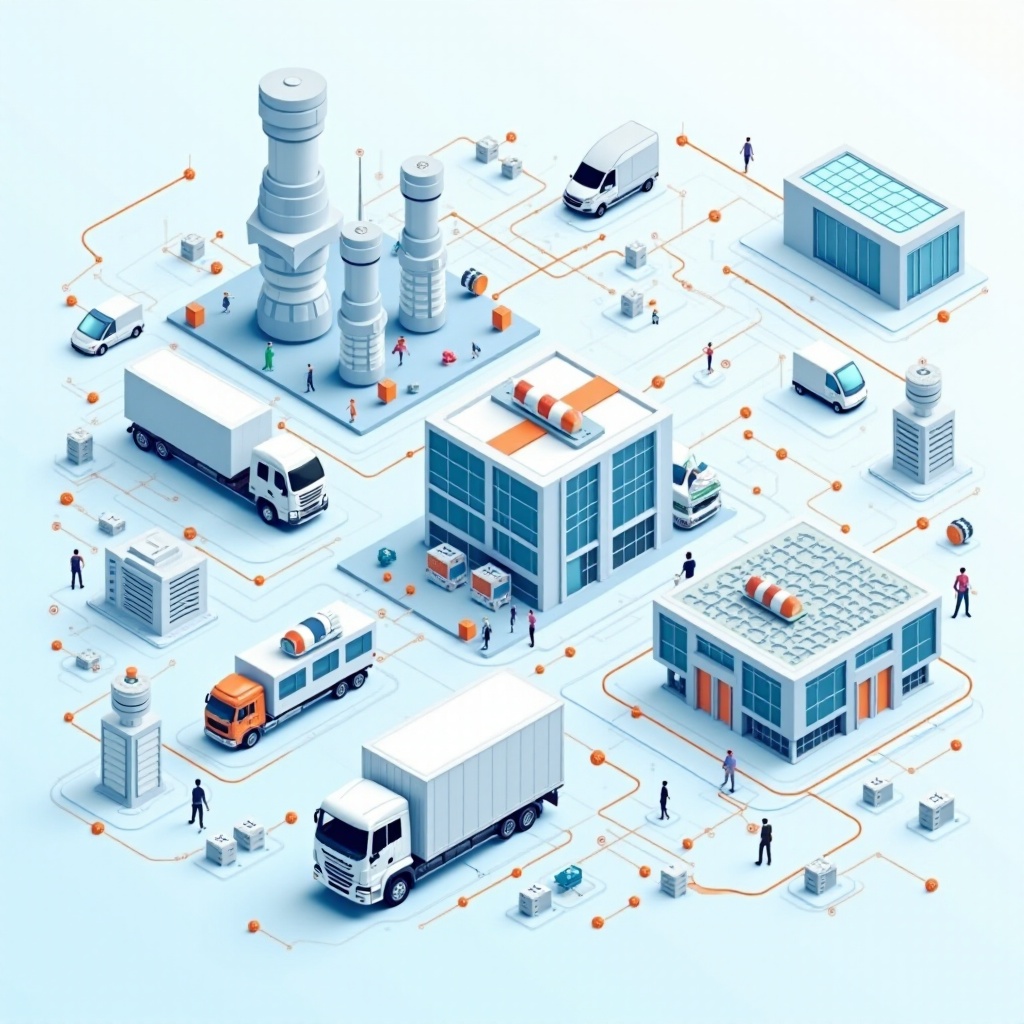The pharmaceutical supply chain is vital for ensuring medications reach patients safely and efficiently. This complex system involves multiple stakeholders from raw material suppliers to end consumers, navigating a path from production to delivery. Understanding this supply chain’s components and challenges is critical for optimizing pharmaceutical distribution.
Introduction
In the healthcare industry, the pharmaceutical supply chain serves a crucial role in bridging the gap between medication production and patient access. From procuring raw materials to transporting drugs to pharmacies, each aspect functions to deliver essential medicines. Companies involved need to address the multitude of components and challenges, such as regulatory compliance and security threats. Additionally, staying abreast of technological advances and future trends becomes vital to maintaining a resilient and efficient supply chain.

Key Components of the Pharmaceutical Supply Chain
The success of the pharmaceutical supply chain relies on several key components working cohesively:
Sourcing of Raw Materials
The initial stage begins with sourcing raw materials. Pharmaceuticals require high-quality and reliable sources for active pharmaceutical ingredients (APIs) and excipients. This stage demands strict quality evaluations and supplier assessments to ensure the safety and efficacy of the final product.
Manufacturing Process
The transition from raw materials to finished pharmaceutical products occurs during the manufacturing process. This stage involves complex procedures such as compounding, mixing, granulation, and encapsulation, all adhering to Good Manufacturing Practices (GMP) to meet stringent safety and quality standards.
Packaging and Labeling
Packaging and labeling are crucial to protecting medications from contamination and ensuring proper usage. This involves processes like blister packaging and precise labeling. Accurate labeling is essential for regulatory compliance and preventing medication errors, ensuring that every product reaching a pharmacy or hospital is safe for consumption.
By understanding each component, companies can anticipate challenges, including those in logistics and distribution, which are equally critical for seamless operations.
Distribution Channels and Logistics in Pharmaceuticals
An effective supply chain depends on efficient distribution channels and logistics, guaranteeing the quality and safety of pharmaceuticals as they journey to end users.
Warehousing and Inventory Management
Pharmaceutical warehousing involves storing products in controlled environments to preserve their quality. Effective inventory management prevents operational issues like stockouts or overstocking, ensuring a steady supply to meet demand.
Transportation and Cold Chain Logistics
Transportation covers the journey of medicines from manufacturers to distribution centers, pharmacies, and hospitals. Cold chain logistics specifically support temperature-sensitive drugs, maintaining product integrity across all transit stages.
Regulatory Compliance in Logistics
Adhering to regulatory compliance throughout transportation and storage is non-negotiable. Compliance with standards set by authorities like the FDA ensures that companies address safe handling, storage, and distribution practices.
As companies tackle these logistical challenges, they must simultaneously contend with broader supply chain challenges impacting efficacy and product safety.
Challenges in the Pharmaceutical Supply Chain
Navigating the pharmaceutical supply chain involves overcoming specific challenges that threaten product integrity and supply chain efficiency.
Quality Control and Assurance
Integral to the supply chain is persistent quality control involving routine testing and careful inspections to maintain drug safety standards. Implementing comprehensive quality assurance systems is vital for early defect detection, preventing impure products from reaching consumers.
Counterfeiting and Security Issues
Counterfeiting remains a prevalent issue, risking patient safety and company credibility. Companies employ serialization and sophisticated track-and-trace systems to safeguard against counterfeit drugs entering the market.
Supply Chain Disruptions
External factors like natural disasters and global pandemics pose significant disruptions in pharmaceutical supply chains. Companies benefit from robust risk management strategies, enabling them to better anticipate and weather such disruptions.
With challenges in mind, technological innovations offer a pathway to refining and future-proofing the supply chain.
Technological Innovations Enhancing the Supply Chain
Modern technologies provide transformative improvements in the pharmaceutical supply chain, boosting efficiency and security.
Role of AI and Machine Learning
Artificial intelligence and machine learning technologies optimize supply chain processes through sophisticated data analysis and demand forecasting. These innovations facilitate cost reductions, enhanced decision-making, and streamlined operations.
Blockchain for Enhanced Traceability
Blockchain technology offers an unprecedented level of transparency, ensuring secure and verifiable records of each transaction and movement within the supply chain. This results in improved security by enabling precise tracking of authenticity throughout the chain’s stages.
Automation and IoT Solutions
Automation paired with IoT innovations enhance operational efficiency by automating tasks and providing real-time data visibility. These solutions enable precise monitoring of inventory and shipment tracking, significantly improving management practices across supply lines.
By leveraging these technologies, companies gain a competitive edge while embracing future trends shaping the industry.

Future Trends in the Pharmaceutical Supply Chain
Adapting to emerging trends is necessary for pharmaceutical companies seeking to stay competitive and efficient. Embracing sustainable practices and personalization represents crucial elements for evolution.
Sustainability and Green Practices
Environmental sustainability gains prominence as companies endeavor to minimize their eco-impact. Practices such as adopting eco-friendly packaging and investing in energy-efficient processes forge a pathway towards a more sustainable supply chain.
Personalization and Precision Medicine
The evolving trend toward personalization tailors medications to individual patients, enhancing treatment effectiveness and minimizing adverse effects. Precision medicine represents both an opportunity and a transforming force within the pharmaceutical supply chain.

Conclusion
The pharmaceutical supply chain, complex and interconnected, plays a pivotal role in delivering medications safely and efficiently from production to patients. Comprehensive understanding of its components, strategic management of challenges, and embracing technological innovations ensure an optimized supply chain. By preparing for future trends, companies can achieve reliability and agility, ensuring that life-saving medications remain accessible to those in need.
Frequently Asked Questions
What are the main phases of the pharmaceutical supply chain?
The primary phases include sourcing raw materials, manufacturing, packaging and labeling, distribution channels, and logistics, ensuring medication reaches the end-user safely.
How does technology improve the pharmaceutical supply chain?
Technology, such as AI, blockchain, and IoT, enhances the supply chain by improving efficiency, accuracy, and security, while reducing costs and streamlining processes.
What challenges does the pharmaceutical supply chain face today?
Key challenges include maintaining quality control, combating counterfeiting, and mitigating disruptions, requiring companies to implement risk management and security measures.
